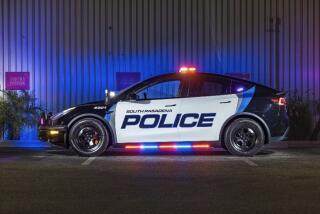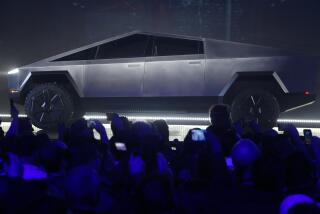SWAT Team Receives 14 Tons of Protection
Move over Ram, the BEAR is here.
A new SWAT truck that resembles a Hummer on steroids is the latest weapon in the Los Angeles Police Department’s arsenal.
The monster truck, dubbed the LAPD Rescue Vehicle, is 14 tons of protection. Nothing short of a rocket-propelled grenade will trouble this powerhouse clad in a half-inch of high-tech ballistic steel.
And with a growling, 300-horsepower Caterpillar engine, a front end capable of breaching concrete walls and four-wheel drive, there few places the BEAR can’t go. Inside, 15 fully equipped Special Weapons and Tactics officers can be at the ready.
The BEAR’s arrival means the LAPD can mothball a pair of Vietnam War-vintage V-100 armored vehicles, better known as Rams, from the era of former Police Chief Daryl F. Gates.
BEAR stands for Ballistic Engineered Armored Response. It is one of the first vehicles specifically built as a SWAT truck. Painted black, it made its debut, along with the designer gowns, outside the Oscars, idling on a Hollywood High School athletic field.
“It’s in a league of its own,” said Assistant Chief Jim McDonnell, his voice resonating with pride. “The BEAR could be used for an armed confrontation, a barricaded suspect or a hostage crisis. It’s a great platform to perform rescues in a lethal environment.”
These might be wheels anyone would be proud to drive. But it is more than a nice ride. McDonnell said that, thanks to the BEAR, he knows his officers probably will never again be as vulnerable in a crisis as they were when outgunned in the 1997 North Hollywood bank robbery shootout.
“This is a safe haven,” said Lt. Mike Albanese, supervisor of the SWAT unit. “The mission is to rescue community members or law enforcement from unfolding threats or pending threats. It’s a bulletproof vehicle. Shoot the tires and it will still keep on running.”
As Albanese made clear, it’s a rescue vehicle, not an assault vehicle. But, like the old Ram, it can still pack a punch.
At the department’s request, the manufacturer, Lenco Industries Inc., adapted the vehicle by adding a 10-foot metal ram.
Albanese said the extra weight forced the manufacturer to add air brakes like those on an 18-wheeler. Anyone behind its wheel must be licensed to drive a big rig.
The vehicle is the first of its kind on the West Coast.
Nearly three dozen BEARs are already at work around the nation. Len Light, president of Pittsfield, Mass.-based Lenco, said demand has climbed steadily as local agencies prepare for potential acts of terrorism since the Sept. 11 attacks.
The LAPD already has a smaller version on order. The Los Angeles County Sheriff’s Department soon will have its own BEAR, and a couple of the smaller versions to boot.
Albanese said the new truck is not only a mechanism to extricate people, but a delivery system for items such as phones and food during negotiations with armed suspects.
Incidents such as the North Hollywood shootout and the siege at Columbine High School in Colorado, where officers had to borrow an armored bank car to rescue children from a pair of armed students, led to the concept of the BEAR and a series of other vehicles, Light said.
“Typically, armored money trucks aren’t that effective against armor-piercing ammunition,” he said. “This vehicle is off the charts. An M-16 -- no problem.”
Light’s bragging was put to the test in Virginia a few weeks ago when the vehicle was subjected to fire from an AK-47. “The bullets bounced off,” Light said.
“In Northern Illinois, they’ve used it a bunch of times to defuse situations,” he added. “In one recent grocery store hostage crisis, the vehicle drove by the front of the store and the guy with the gun sees it and gave up.”
As many as 35 people can be packed into the BEAR because its back seats flip up. “The back step is designed so children can easily step on up into the vehicle,” Light said.
It is more truck than tank for a reason. Military surplus vehicles such as the V-100s, Light said, are not the kind of thing many Americans want to see on their streets.
During the mid-1980s, tensions flared in Los Angeles when the Rams battered down the walls of places believed to be “rock houses” -- fortified drug dens.
With Gates in the passenger seat, the 14-foot steel ram of a V-100 smashed down the wall of a Pacoima home in 1985, only to find two women and three children eating ice cream. The take: a small amount of marijuana.
To some police watchdog groups, the Rams became a symbol that the LAPD was acting like an occupying army.
The V-100s were so slow and mechanically troubled that they had to be moved on flatbed trucks.
Given a life-and-death situation, at most 10 people could squeeze inside, Albanese said. The V-100s’ soaring maintenance costs provided the impetus for purchasing the BEAR.
The new vehicle cost $250,000, but a quick tour reveals no luxuries. The austere interior includes two front cab seats, two fold-up benches and a roof hatch inside what feels like a tiny submarine. Each side panel contains slits, like those on a medieval castle, from which police can fire weapons.
The first regular call for duty came last month, when a search warrant was served on potentially heavily armed suspects.
The BEAR came away unscathed.
More to Read
Sign up for Essential California
The most important California stories and recommendations in your inbox every morning.
You may occasionally receive promotional content from the Los Angeles Times.











